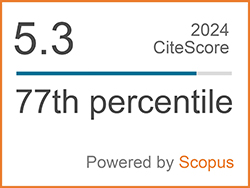Green Synthesis of Biomass-Derived Carbon Quantum Dots from Syzygium aromaticum via Carbonization-Assisted Ultrasonication for a Selective Colorimetric Sensor of Ag⁺ in Environmental Waters
Abstract
Keywords
[1] F. Allambergenova, Z. Smanova, N. Qutlimurotova, A. Abdreymov, F. Sobirova, R. Qutlimurotova, and K. Yakhshinorov, “Synthesis of carbon dots based on chitosan and melamine and their application in detecting vanadate (V) anions,” Chinese Journal of Analytical Chemistry, vol. 53, no. 7, 2025, Art. no. 100538, doi: 10.1016/ j.cjac.2025.100538.
[2] Y. Zhou, W. Zhang, and R. M. Leblanc, “Structure–property–activity relationships in carbon dots,” Journal of Physical Chemistry B, vol. 126, pp. 10777–10796, 2022, doi: 10.1021/ acs.jpcb.2c06856.
[3] H. Wang, Y. Li, Q. Che, X. Liu, S. Zhang, H. Yang, and L. Hu, “Liquid-like carbon dots as lubricating grease additives,” ACS Applied Nano Materials, vol. 8, pp. 2554–2562, 2025, doi: 10.1021/acsanm.4c06881.
[4] E. G. Amrutha and S. Manivannan, “Carbon dots–based ratiometric fluorescence sensor for hippuric acid,” Physica Status Solidi (A), vol. 219, 2022, Art. no. 2200076, doi: 10.1002/pssa. 202200076.
[5] P. Venugopalan, N. Vidya, and C. Maya, “Cassia fistula flower extract derived carbon dots for photocatalytic degradation of methylene blue,” International Journal of Environmental Analytical Chemistry, vol. 104, pp. 7743–7753, 2024, doi: 10.1080/03067319.2023.2182208.
[6] A. Tiron-Stathopoulos and K. Dimos, “Carbon dots’ unusual optoelectronic properties in silica aerogels,” Journal of Sol-Gel Science and Technology, vol. 112, pp. 456–467, 2024, doi: 10.1007/s10971-024-06538-y.
[7] T. Riaz et al., K. M. Alotaibi, and M. Alshalwi, “Carbon dots and nitrogen-doped carbon dots–metal oxide nanocomposites: robust agents for effective sensing of ions,” Journal of Materials Science: Materials in Electronics, vol. 35, 2024, Art. no. 940, doi: 10.1007/s10854-024-12692-4.
[8] P. Li et al., “Recent advances of carbon dots as new antimicrobial agents,” SmartMat, vol. 3, pp. 226–248, 2022, doi: 10.1002/smm2.1131.
[9] A. Ferrer-Ruiz, L. Rodríguez-Pérez, N. Martín, and M. Á. Herranz, “Post-synthetic graphitization and photoluminescence tuning of carbon dots from L-glutamic acid,” Small Structures, vol. 6, 2025, Art. no. 2400532, doi: 10.1002/sstr.2024 00532.
[10] W. Xie et al., “Sterically chained amino acid-rich water-soluble carbon quantum dots as a robust tumor-targeted drug delivery platform,” Nature Communications, vol. 16, 2025, Art. no. 2716, doi: 10.1038/s41467-025-57531-0.
[11] N. Sharma, A. Sharma, and H.-J. Lee, “The antioxidant properties of green carbon dots: a review,” Environmental Chemistry Letters, 2025, doi: 10.1007/s10311-025-01831-w.
[12] S. A. Akbar, L. Mauliza, and R. R. Fazli, “Recent advances in carbon-based adsorbent materials for ammonium removal from water,” BIO Web of Conferences, vol. 156, 2025, Art. no. 02014, doi: 10.1051/bioconf/202515602014.
[13] S. A. Akbar and K. Khairunnisa, “Seaweed-based biosorbent for the removal of organic and inorganic contaminants from water: A systematic review,” BIO Web of Conferences, vol. 87, 2024, Art. no. 02011, doi: 10.1051/bioconf/20248702011.
[14] Gunture and T. Y. Lee, “Biomass-derived multiatom-doped carbon dots for the photocatalytic reduction of Cr(VI) and precipitation of Cr(III),” NPJ Clean Water, vol. 7, 2024, Art. no. 132, doi: 10.1038/s41545-024-00426-2.
[15] R. Yadav, V. Lahariya, Vikas, A. K. Singh, A. Das, and A. Yadav, “Fluorometric sensing and nanomolar level detection of heavy metal ions using nitrogen doped carbon dots,” Emergent Materials, vol. 8, pp. 363–377, 2025, doi: 10.1007/s42247-024-00825-8.
[16] S. A. Akbar, M. Hasan, M. Nazar, I. Zulfahmi, E. Miswar, M. Iqhrammullah, and Z. Jalil, “Fluorescent carbon quantum dots from Syzygium aromaticum as a selective sensor for Fe³⁺ and Cd²⁺ detection in aqueous solution,” Case Studies in Chemical and Environmental Engineering, vol. 11, 2025, Art. no. 101166, doi: 10.1016/j.cscee.2025.101166.
[17] G. R. Tortella, O. Rubilar, N. Durán, M. C. Diez, M. Martínez, J. Parada, and A. B. Seabra, “Silver nanoparticles: Toxicity in model organisms as an overview of its hazard for human health and the environment,” Journal of Hazardous Materials, vol. 390, 2020, Art. no. 121974, doi: 10.1016/ j.jhazmat.2019.121974.
[18] M. I. S. D. Cruz, N. Thongsai, M. D. G. de Luna, I. In, and P. Paoprasert, “Preparation of highly photoluminescent carbon dots from polyurethane: Optimization using response surface methodology and selective detection of silver (I) ion,” Colloids and Surfaces A: Physicochemical and Engineering Aspects, vol. 568, pp. 184–194, 2019, doi: 10.1016/j.colsurfa.2019.02.022.
[19] N. Arumugam and J. Kim, “Synthesis of carbon quantum dots from broccoli and their ability to detect silver ions,” Materials Letters, vol. 219, pp. 37–40, 2018, doi: 10.1016/j.matlet.2018. 02.043.
[20] S. A. Akbar, M. Hasan, Z. Jalil, I. Zulfahmi, M. Iqhrammullah, and N. Safina, “Enhanced ammonia nitrogen filtration using NaOH-activated Manihot utilissima peel carbon: Application in recirculating aquaculture systems for Nile tilapia,” Chemosphere, vol. 385, 2025, Art. no. 144537, doi: 10.1016/j.chemosphere. 2025.144537.
[21] A. Suryawanshi et al., “Large scale synthesis of graphene quantum dots (GQDs) from waste biomass and their use as an efficient and selective photoluminescence on–off–on probe for Ag⁺ ions,” Nanoscale, vol. 6, pp. 11664–11670, 2014, doi: 10.1039/C4NR02494J.
[22] P. Murugesan, N. Libiya, J. A. Moses, and C. Anandharamakrishnan, “Fluorescence resonance energy transfer-based sensor with silver-conjugated orange peel waste-derived carbon dots for melamine detection,” Carbon Letters, vol. 33, pp. 2335–2348, 2023, doi: 10.1007/ s42823-023-00563-7.
[23] S. Tang et al., “A smartphone-integrated optical sensing platform based on Lycium ruthenicum derived carbon dots for real-time detection of Ag⁺,” Science of The Total Environment, vol. 825, 2022, Art. no. 153913, doi: 10.1016/ j.scitotenv.2022.153913.
[24] F. El-akhal et al., “Phytochemical screening, chemical composition and larvicidal efficacy of Syzygium aromaticum extracts and essential oil against Culex pipiens,” Tropical Journal of Natural Product Research, vol. 8, pp. 5962–5967, 2024, doi: 10.26538/tjnpr/v8i1.35.
[25] R. Kumar, V. B. Kumar, and A. Gedanken, “Sonochemical synthesis of carbon dots, mechanism, effect of parameters, and catalytic, energy, biomedical and tissue engineering applications,” Ultrasonics Sonochemistry, vol. 64, 2020, Art. no. 105009, doi: 10.1016/ j.ultsonch.2020.105009.
[26] I. Diwan and G. K. Tripathi, and P. S. Khare, “Synthesis of green fluorescent, energy efficient nitrogen doped carbon quantum dots,” Optik, vol. 303, 2024, Art. no. 171725, doi: 10.1016/j.ijleo.2024.171725.
[27] S. K. Saraswat et al., “Carbon quantum dots: A comprehensive review of green synthesis, characterization and investigation their applications in bioimaging,” Inorganic Chemistry Communications, vol. 162, 2024, Art. no. 112279, doi: 10.1016/j.inoche.2024.112279.
[28] V. A. Sadhu, T. J. Park, and S. K. Kailasa, “Synthesis of green fluorescent carbon dots using cysteine and maltose as ecofriendly ligands for the detection of venlafaxine anti-depression drug in pharmaceutical and plasma samples,” Inorganic Chemistry Communications, vol. 168, 2024, Art. no. 112980, doi: 10.1016/j.inoche. 2024.112980.
[29] X. Long, H. Liu, J. Hu, and S. Wu, “Green synthesis of N,S dual heteroatom-doped fluorescent carbon dots (N,S-CDs) and their applications in gentamicin sensing and dual-switch anti-counterfeiting encryption,” Dyes and Pigments, vol. 231, 2024, Art. no. 112413, doi: 10.1016/j.dyepig.2024.112413.
[30] J.-H. Mou et al., “Green synthesis of lactic acid and carbon dots using food waste and seashell waste,” Green Chemistry, vol. 26, pp. 8282–8297, 2024, doi: 10.1039/d4gc01890g.
[31] N. Sharma et al., “Green hydrothermal approach for the synthesis of carbon quantum dots from waste tea bags for acrylamide detection in drinking water: A fluorescence assay validated by HPLC-PDA analysis,” Food Chemistry: X, vol. 25, 2025, Art. no. 102043, doi: 10.1016/ j.fochx.2024.102043.
[32] M. Gagana et al., “Green synthesis of carbon dots encapsulated MoO₃:La³⁺ for enhanced photocatalytic degradation, dactyloscopy and real-time FP detection using YOLOv8x,” Journal of the Taiwan Institute of Chemical Engineers, vol. 170, 2025, Art. no. 106032, doi: 10.1016/j.jtice.2025.106032.
[33] A. Daulay et al., “Green sources for carbon dots synthesis in sensing for food application – A review,” Biosensors and Bioelectronics: X, vol. 17, 2024, Art. no. 100460, doi: 10.1016/j.biosx. 2024.100460.
[34] S. Patra, A. K. Golder, and R. V. S. Uppaluri, “Green synthesis of carbon dots from mature green tea leaves for label-free fluorescence sensing of chromium(VI),” Optical Materials, vol. 154, 2024, Art. no. 115767, doi: 10.1016/ j.optmat.2024.115767.
[35] C. W. Backes, F. B. Reis, G. B. Strapasson, M. Assis, E. Longo, and D. E. Weibel, “Green synthesis of carbon quantum dots for enhancing photocatalytic activity: Hydrogen/oxygen evolution and dye photodegradation,” Catalysis Today, vol. 443, 2025, Art. no. 114996, doi: 10.1016/j.cattod.2024.114996.
[36] H. Chen, G. Huang, Y. Li, and Y. Huang, “In situ green synthesis of Rosa sterilis-based carbon dots for Fe³⁺ fluorescent sensing in baijiu,” Food Bioscience, vol. 62, 2024, Art. no. 105403, doi: 10.1016/j.fbio.2024.105403.
[37] I. B. Raval, V. N. Mehta, S. Jha, T. J. Park, and S. K. Kailasa, “Synthesis of green emissive Plectranthus scutellarioides carbon dots for sustainable and label-free detection of phytohormone indole-3-acetic acid,” Inorganic Chemistry Communications, vol. 171, 2025, Art. no. 113660, doi: 10.1016/j.inoche.2024.113660.
[38] M. Idrees, N. Saqib, and G. Zaman, “Green synthesis of carbon dots (CDs) and their use for selective determination of Pb²⁺,” Spectrochimica Acta Part A: Molecular and Biomolecular Spectroscopy, vol. 326, 2025, Art. no. 125303, doi: 10.1016/j.saa.2024.125303.
[39] Y. Yu et al., “Green synthesis of carbon quantum dots from nutshells for enhanced performance in dye-sensitized solar cells,” RSC Advances, vol. 15, pp. 7938–7947, 2025, doi: 10.1039/d4ra08649j.
[40] C. O. Ugwuoke, M. Ghali, and A. A. El-Moneim, “Green synthesis of carbon dots from Nigella sativa seeds for supercapacitor application,” Journal of Energy Storage, vol. 95, 2024, Art. no. 112634, doi: 10.1016/j.est.2024.112634.
[41] Z. Li, Z. Miao, J. Shen, J. Wang, and L. Lin, “Green synthesis of carbon dots by microflow method and their application as sunscreen agent,” Chinese Journal of Chemical Engineering, vol. 77, pp. 135–143, 2025, doi: 10.1016/j.cjche. 2024.10.008.
[42] I. Chen, T. Li, C. Lin, Y. Hou, S. Cheng, and B. Gao, “Green synthesis of red-emitting carbon dots for bioimaging, sensing, and antibacterial applications,” Spectrochimica Acta Part A: Molecular and Biomolecular Spectroscopy, vol. 328, 2025, Art. no. 125458, doi: 10.1016/ j.saa.2024.125458.
[43] V. Renuga et al., “Green synthesis of biocompatible fluorescent carbon dots from bitter gourd for effective metal sensing and biological applications,” Sensing and Bio-Sensing Research, vol. 47, 2025, Art. no. 100751, doi: 10.1016/ j.sbsr.2025.100751.
[44] J. Hu and S. Wu, “Green and sustainable synthesis of fluorescent carbon dots from crown daisy for information encryption application,” Journal of Molecular Structure, vol. 1324, 2025, Art. no. 140794, doi: 10.1016/j.molstruc.2024. 140794.
[45] S. K. Kalifathullah, S. Alaguvel, and D. Sundaramurthy, “Efficient synthesis of green nitrogen-doped carbon dots as a versatile nanoprobe for antibacterial, cytotoxic, in-vitro imaging, and anti-counterfeit applications,” Inorganic Chemistry Communications, vol. 178, 2025, Art. no. 114473, doi: 10.1016/j.inoche. 2025.114473.
[46] H. K. Kohli and D. Parab, “Green synthesis of carbon quantum dots and applications: An insight,” Next Materials, vol. 8, 2025, Art. no. 100527, doi: 10.1016/j.nxmate.2025.100527.
[47] B. I. Salman, H. A. Batakoushy, R. E. Saraya, A. I. Hassan, A. Al-Harrasi, and A. E. Ibrahim, “Comprehensive investigation of Prunus armeniaca for natural green synthesis of carbon quantum dots; Applications as fluorescent nano-probes for ramipril,” Talanta, vol. 292, 2025, Art. no. 128014, doi: 10.1016/j.talanta.2025.128014.
[48] I. Ramajayam and A. Palaniappan, “Facile and green synthesis of highly fluorescent boron and nitrogen-doped carbon dots (BN-CDs) for the fluorimetric detection of Au³⁺ ions in aqueous media and in in vitro cell imaging,” Colloids and Surfaces A: Physicochemical and Engineering Aspects, vol. 709, 2025, Art. no. 136062, doi: 10.1016/j.colsurfa.2024.136062.
[49] R. Ali et al., “A novel red emissive glutathione-capped carbon dots embedded within molecularly-imprinted polymers for adsorption and fluorescent sensing of malachite green in food samples,” Microchemical Journal, vol. 212, 2025, Art. no. 113376, doi: 10.1016/j.microc. 2025.113376.
[50] H. Xu, W. Zhan, M. Wan, X. Bao, and L. Tang, “Research on green synthesis and performance analysis of biomass-derived carbon quantum dots,” Industrial Crops and Products, vol. 227, 2025, Art. no. 120775, doi: 10.1016/j.indcrop. 2025.120775.
[51] W. Zhang et al., “A universal sensing platform based on iron and nitrogen co-doped carbon dots for detecting hydrogen peroxide and related metabolites in human fluid by ratiometric fluorometry and colorimetry,” Spectrochimica Acta Part A: Molecular and Biomolecular Spectroscopy, vol. 272, 2022, Art. no. 121003, doi: 10.1016/j.saa.2022.121003.
[52] D. Yang, T. Shao, L. Zhang, X. Wang, and Q. Yue, “Novel carbon dots from phenylenediamine for simultaneous detection of peroxydisulfate and phosphate with a smartphone by dual-channel of fluorometry and colorimetry,” Food Chemistry, vol. 472, 2025, Art. no. 142905, doi: 10.1016/j.foodchem.2025.142905.
[53] H. Wang et al., “Gadolinium-doped carbon dots as a ratiometric fluorometry and colorimetry dual-mode nano-sensor based on specific chelation for morin detection,” Sensors and Actuators B: Chemical, vol. 352, 2022, Art. no. 130991, doi: 10.1016/j.snb.2021.130991.
[54] X.-H. Duan, H.-W. Li, and Y. Wu, “A smart ratiometric fluorescence and colorimetry dual-responsive sensor for morin determination based on the complex between carbon quantum dots and polyethyleneimine,” Analytica Chimica Acta, vol. 1243, 2023, Art. no. 340814, doi: 10.1016/j.aca.2023.340814.
[55] Y. Kong, T. Lei, Y. He, and G. Song, “Background-free room temperature phosphorescence and digital image colorimetry detection of melamine by carbon nitride quantum dots in cellulose matrix with smartphone-based portable device,” Food Chemistry, vol. 390, 2022, Art. no. 133135, doi: 10.1016/j.foodchem.2022.133135.
[56] Q. Chen et al., “Ratio fluorescence and smartphone-assisted colorimetry dual-mode detection of creatinine based on F, B, N-doped of red fluorescent carbon dots,” Analytica Chimica Acta, vol. 1349, 2025, Art. no. 343815, doi: 10.1016/j.aca.2025.343815.
[57] J.-C. Jin et al., “A novel method for the detection of silver ions with carbon dots: Excellent selectivity, fast response, low detection limit and good applicability,” Sensors and Actuators B: Chemical, vol. 267, pp. 627–635, 2018, doi: 10.1016/j.snb.2018.04.036.
[58] P. Murugesan, J. A. Moses, and C. Anandharamakrishnan, “One step synthesis of fluorescent carbon dots from neera for the detection of silver ions,” Spectroscopy Letters, vol. 53, pp. 407–415, 2020, doi: 10.1080/ 00387010.2020.1764589.
[59] J. Guo, S. Ye, H. Li, J. Song, and J. Qu, “Novel carbon dots with dual excitation for imaging and silver ion detection in living cells,” Dyes and Pigments, vol. 183, 2020, Art. no. 108723, doi: 10.1016/j.dyepig.2020.108723.
[60] I. Gontrani, E. M. Bauer, A. Nucara, P. Tagliatesta, and M. Carbone, “Highly specific silver ion detection by fluorescent carbon quantum dots,” Chemosensors, vol. 10, 2022, Art. no. 90362, doi: 10.3390/chemosensors 10090362.
[61] X. Gao et al., “One-pot synthesis of carbon nanodots for fluorescence turn-on detection of Ag⁺ based on the Ag⁺-induced enhancement of fluorescence,” Journal of Materials Chemistry C, vol. 3, pp. 2302–2309, 2015, doi: 10.1039/ C4TC02582B.
[62] I. Marcus, “Testing above the limit: Drinking water contamination and test scores,” Journal of Public Economics, vol. 243, 2025, Art. no. 105313, doi: 10.1016/j.jpubeco.2025.105313.
[63] L. Ogisma, F. C. O’Donnell, W. Sawadgo, J. J. Molnar, G. Huluka, and E. Laguerre, “Pricing drinking water testing in northern Haiti: Financial sensitivity to operating costs, user demand, and economic conditions,” Heliyon, vol. 10, 2024, Art. no. e38063, doi: 10.1016/ j.heliyon.2024.e38063.
[64] W. Zhong and J. Yang, “Fluorescent carbon quantum dots for heavy metal sensing,” Science of The Total Environment, vol. 957, 2024, Art. no. 177473, doi: 10.1016/j.scitotenv.2024.177473.
[65] C. Tian et al., “Machine-learning-enhanced fluorescent nanosensor based on carbon quantum dots for heavy metal detection,” ACS Applied Nano Materials, vol. 7, 2024, Art. no. 5576–5586, doi: 10.1021/acsanm.4c00359.
[66] V. Chobpattana, T. Sangtawesin, P. Khaopueak, and K. Wechakorn, “Sugar derived-fluorescent carbon quantum dots conjugated glutathione for sensing heavy metal ions and antioxidant activity,” Materials Science and Engineering: B, vol. 313, 2025, Art. no. 117956, doi: 10.1016/j.mseb.2024.117956.
[67] H. Javeria, M. Q. Abbas, S.-H. Chen, B. E. Keshat, and Z. Du, “Scalability of sulfur-functionalized carbon quantum dots from peanut shells: A sustainable sensor of high colorimetric heavy metal detection,” Journal of Environmental Chemical Engineering, vol. 13, 2025, Art. no. 115821, doi: 10.1016/j.jece.2025. 115821.
DOI: 10.14416/j.asep.2025.09.011
Refbacks
- There are currently no refbacks.
 Applied Science and Engineering Progress
Applied Science and Engineering Progress







